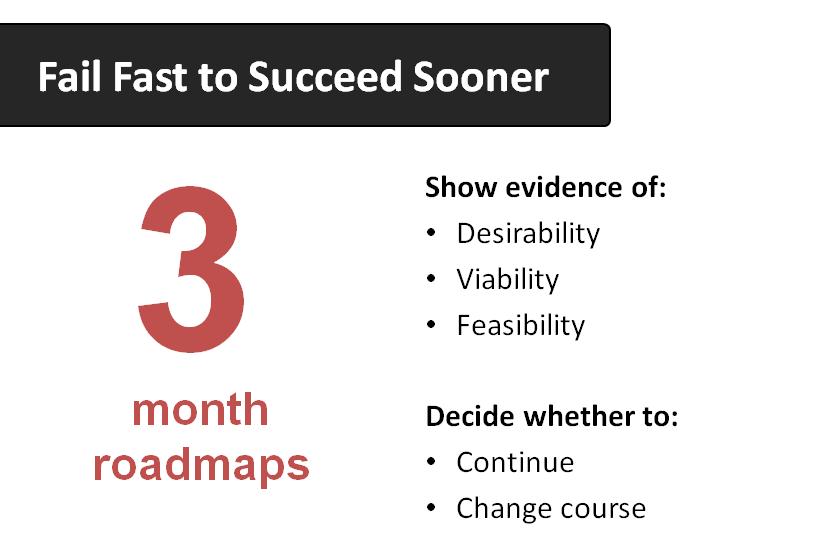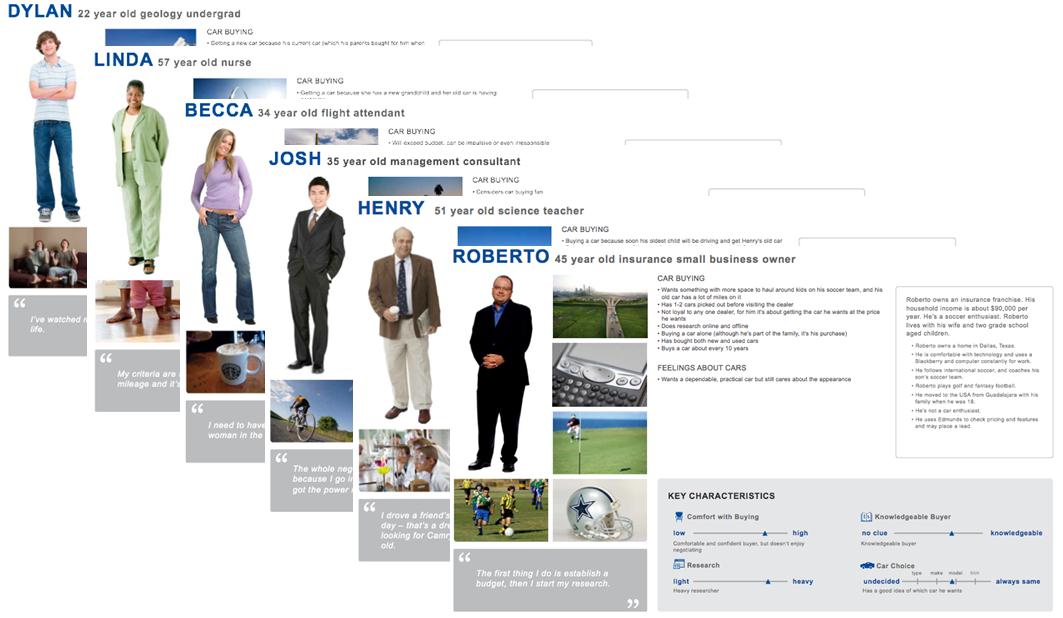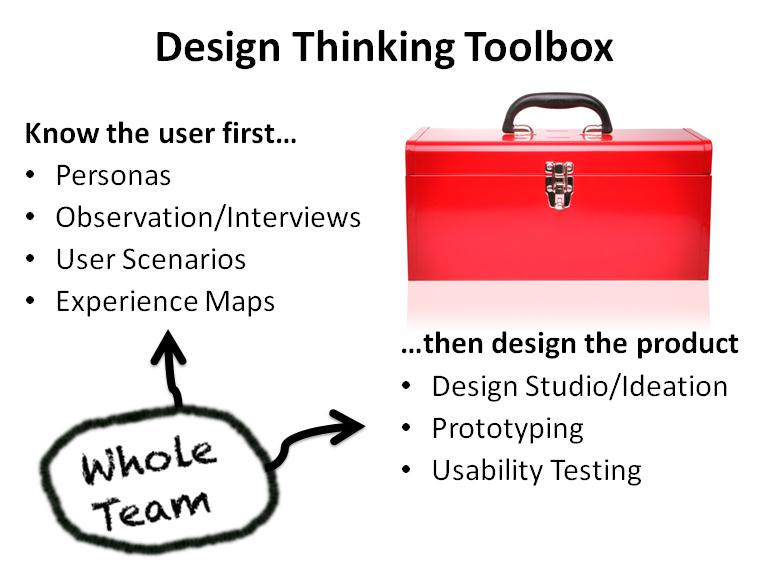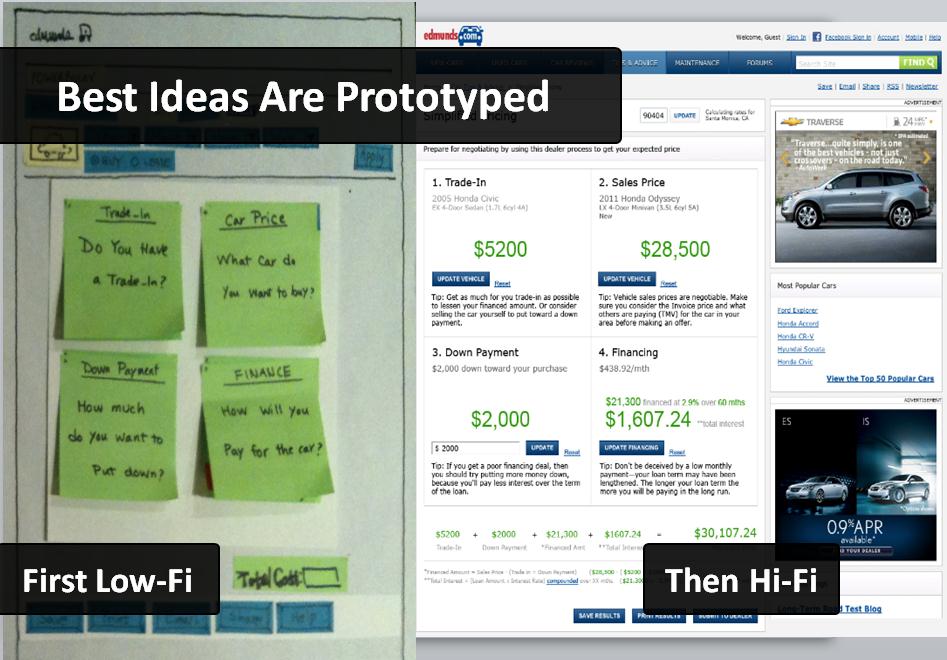Story:
How a Shopping Cart Transformed the Way We Work: “User Centric & Employee Driven”
In 2010, Edmunds.com, Inc. faced slowing business growth and increased pressure to innovate from a highly competitive market. Our traditional method of building our product development road map with solutions dictated from senior executives was no longer producing the desired results. Employees wanted a say in what they built, and executives knew that we needed to innovate or fall prey to the competition. In our quest for executional excellence, we had lost sharp focus on our users, creating products and features that weren’t necessarily rooted in solving real user problems. We needed to refocus.
In mid-2010, we made the decision to wholeheartedly adopt design thinking (user centered design), applying it first to the development of our 2011 product road map. Rather than executives identifying solutions to build, they drafted broad challenge statements and assigned budget and teams to each. These teams would ultimately build their own roadmaps, based on insights gleaned from research with real consumers. Teams learned how to quickly prototype ideas and to celebrate failures as long we learned something. Employees were no longer passive executers; instead, they were armed with tools and techniques that empowered them to innovate and drive product design. We started a striking transformation.
Edmunds.com Inc. publishes Web sites that empower, engage and educate automotive consumers, enthusiasts and insiders. Edmunds.com, the premier online resource for automotive information, launched in 1995 as the first automotive information Web site and hosts the most established automotive community online. InsideLine.com is the most widely read automotive enthusiast Web site. AutoObserver.com provides insightful automotive industry commentary and analysis. Edmunds.com Inc. is headquartered in Santa Monica, California, and maintains a satellite office in suburban Detroit. Edmunds.com Inc. is a private, family owned company with approximately 500 employees.
Edmunds.com is a market leader in the Automotive Online Media industry, one where recent innovations in Internet technology have lowered the barrier to entry, resulting in increased competition. Several competitors exist in major business areas like New Cars, Used Cars, Enthusiast, etc. Other players in the market include: Kelly Blue Book, AutoTrader, Cars.com, and TrueCar.
Edmunds is a phenomenal machine when it comes to churning out new features and data for our users. For example, in 2010, we pulled off the most successful project in the company’s history by redesigning our entire website from the ground up, writing more than a million lines of code in the process.
However, despite excelling at execution, we noticed business growth slowing and employee engagement dropping. We took a hard look at our operations and identified a few things:
- The senior executive team (primarily our Chairman and our CEO) dictated the company’s product roadmap. Our highly talented teams were just building to spec, barely engaged in product design, resulting in low employee engagement.
- Our incremental product releases began to take on a ‘bells and whistles’ approach. We were really good at cranking out new features, but they weren’t necessarily rooted in solving real users’ problems. Somehow we lost touch with our real users.
- Users were best known by their Clickstreams. We did a tremendous job analyzing our data, traffic patterns and creating prediction models, but we had no data point for empathizing with our users’ interactions with our site or the car buying process.
So the executive team enlisted the help of author and innovation consultant Matthew May as well as Dr. Jay Conger, Research Chair in Leadership Studies at Claremont McKenna College, to figure out how best to create a culture of innovation aimed at solving real user problems and to give employees more say in product design. The concept of design thinking (a.k.a. human centered design) was introduced, and Conger showed us the now infamous IDEO shopping cart video. The executive team was drawn to the following principles illustrated in the video:
- Observation and research of real consumers drove product design
- Prototypes were used to quickly validate concepts
- Failing fast can be a success, if you learn something from it
- Teams were diverse and titles didn’t matter
We made the decision to adopt design thinking wholeheartedly because it was consistent with our desire to solve real user problems, and it would fundamentally require all team members to engage in product design rather than be passive executers.
Transforming the entire company into design thinkers was a formidable task, and one that requires continuous effort. We aren’t there yet, but we have made significant progress. Here’s a snapshot into what we’ve done so far:
We Overhauled Our Product Planning Process (Summer 2010)
With the executive team fully committed, we began by applying design thinking principles to our annual planning and product road mapping process. Our Chief Operating Officer (COO) drafted a simple set of 12 statements written in the form of a challenge, rather than a product or solution to build. He posted all 12 challenge statements on our internal social networking platform (Yammer) for all employees to review and provide feedback. Once finalized, budgets and resource plans were developed around each challenge. Approximately 40% of company employees were assigned to a challenge (about 180 people). Rather than developing profit and loss forecasts for each challenge, the teams instead were tasked with developing a challenge brief that outlined questions they wanted to explore about their challenge and any constraints that must be considered given existing business commitments. From a road map perspective, we have been accustomed to making big, long bets on new product ideas, but with design thinking we have started operating with 3-month roadmaps for our various product teams. That gives teams four 3-week release cycles to demonstrate progress and show if their product is desirable, viable and feasible. A decision is made every three months about whether to change course or continue. Challenge briefs are submitted prior the challenge’s kickoff, and the teams’ roadmaps are submitted quarterly.

We Trained the Entire Company on Design Thinking Principles (Q3-Q4 2010)
We took a multi-step approach to training the entire company on design thinking during the second half of 2010. We enlisted the help of Jeff Patton & Associates and Matthew May to help us design and deliver training.
- First, we trained a group of about 40 challenge team representatives. Two or three people per team were selected based on their roles (i.e. product/project manager), as well as their leadership abilities. These “challenge leaders” participated in a three-day immersive boot camp where they learned the basic techniques in real-time by applying them to a real-world Edmunds business problem. Additional emphasis was placed on this session to “train the trainer”, providing participants with ideas for how to share/present these concepts to their team. This training occurred in September, 2010.
- Next we invited all employees to a series of 90-minute design thinking overview workshops which aimed to teach key principles of the process to everyone through active participation. Concepts like “your first idea isn’t always your best idea” were presented through quick hands-on exercises. This helped create a common vocabulary about the process and its tools across the company. This training occurred on the heels of the “challenge leader” training.
- Lastly, we educated the executive team on the design thinking framework to ensure they were in a position to coach and support employees during this adoption. This training occurred immediately following the all-employee sessions.
- Throughout the remainder of 2010 and into 2011 – we offered more immersive full day design thinking training sessions for any employee interested and for new employees joining the company. We also brought in a company called Action Learning Associates to provide team building experiences for each challenge team. As part of this activity, challenge team members took a Myers Briggs Personality Type profile and discussed how to assimilate different personality profiles to ‘form’ as a new team.
We Created Personas to Focus Solutions on Our Customers (Q4 2010)
We started to implement design thinking by building personas. Although personas are not new or exclusive to design thinking and have been used by leading companies for at least a couple of decades in product design, they provided the framework for driving user centric design. After interviewing a large number of people, with no emphasis on finding existing users of our web site, we created six corporate personas. Each challenge team picked a primary and secondary persona to focus on when creating their product. It is important to call out that personas are not statistical or demographic representations of users. Teams used the personas to represent things like behaviors, attitudes, and goals, and then used this input to guide new navigation, features and design elements in the solutions they would build.

We Tried it Together (January 2011)
In January, 2011 all 12 challenge teams moved in lockstep through our version of a design thinking framework. The framework provided teams with a set of tools intended to first empathize with the user by selecting a persona, interviewing users to understand their problems, and creating experience maps based on the interview data. Only after we had a strong understanding of our users’ problems did we move on to the next set of tools, which focused on creating lots of ideas and testing how those ideas might solve the problems.

Each team followed a detailed schedule of activities in January. It was a lot of work to coordinate interviews and usability testing sessions with customers for 12 teams in a 3-week window, but it was worth it. Teams developed prototypes to test their best ideas with real users and employees. Early on, the prototypes were extremely “low-fi”, and as they worked their way through usability tests, the teams began to experiment with more sophisticated prototyping tools. By using prototypes, teams are able to gather feedback at the earliest possible point in the process, and the net result is that we can validate ideas more quickly, and we end up writing much less code as result. And we haven’t abandoned our traditional means of input like A/B testing, as 14M Unique visitors a month provide the ultimate test for products that make it onto the web site.

At the end of this 3-week “discovery” phase, we hosted an all-company tradeshow (1 hour, science fair style) in our lobby for teams to showcase their prototypes for employee feedback. We even let employees vote for their favorite. It was quite a sight to watch a system administrator sell the Chairman on his team’s new prototype! This event was such a success that we now host company tradeshows every 6-9 weeks as a way to improve awareness and increase transparency across the company.

We Continue to Learn and Refine
In May 2011, we surveyed employees to identify where we could improve and refine our process. Based on their feedback, we brought our expert consultants back during a 3-week period to provide more focused training sessions on topics like user research and goal writing. During these sessions, we also emphasized team autonomy and empowerment to choose new design thinking tools and techniques (beyond what had been taught in January) to accomplish their goals, so long as they abided by the key principles.
It’s Proliferating
We have introduced Design Thinking across all internal and external product areas and haven’t limited this practice to the consumer facing web site. Business systems and infrastructure teams have really benefited. For example, the infrastructure team had been floundering in demonstrating value from their 2-year long cloud initiative, and after using design thinking to find the real problems of their users (not fancy dashboards) they were able to quickly deliver the API interface that their development and test customers really wanted.
Departments have also begun adopting the design thinking framework by developing their own challenges and putting the tools in action. Our Editorial department recently applied the process to rethink how they create content for the unique needs of our personas. Our HR department has also applied design thinking to address the growing desire for a more refined career development program. Lastly, individuals from various departments are leveraging individual techniques such as experience mapping to help facilitate meetings and uncover insights from their own teams.
At a minimum our site is now being shaped more by the visitors that use it, but it also feels like we have better positioned ourselves for a breakthrough. We have created a culture where failure is accepted, and even celebrated if we learn from it. Disruptive ideas have a tendency to get killed pretty early and often, but with design thinking in play, the chances of something really transformative getting prototyped and tested are definitely more likely.
Challenge: Writing goals that provide the right amount of direction, but don’t squelch creativity, is hard.
Solution: Test, iterate, and test again. Challenge and goal statements are posted publicly in Yammer for employee feedback. We also brought in an expert to help product team leaders write better goals.
Challenge: Balancing executive urgency against time to develop and test prototypes. Our Chairman likes an idea and wants it built immediately.
Solution: Reinforce with executives that building prototypes will allow us to validate ideas more quickly, and is much less expensive and time-consuming than building a fully functional product. Use the research findings to justify the process. If we discover that a prototype tests well with users, then discuss fast tracking. If it fails, refine or kill it before it costs the company real money.
Challenge: Teams felt the design thinking process took too long
Solution 1: Brought in design thinking experts to provide additional tools and techniques so that teams have flexibility to create their design thinking approach based on the problem they are trying to solve. Also, teams are no longer required to be in lockstep with one another, so teams can decide their own design thinking schedule.
Solution 2: Leveraged web technologies to expedite parts of the design thinking process. For example:
- Gave all employees access to Balsamiq, a low fidelity prototyping tool
- Introduced remote usability testing tool to quickly receive user feedback on prototypes
- Streamlined our A/B Testing process to allow more teams to test web site prototypes concurrently
Challenge: Internally facing challenge teams had more difficulty applying the process. For example, we have not yet created corporate personas for internal products.
Solution: Brought in design thinking experts to work 1:1 with each team to tailor the process to their unique needs, and help them create internal personas where it made sense.
Challenge: Providing all product teams the opportunity to conduct basic user experience research with limited resources.
Solution: We taught representatives from each team basic user research skills including research interviewing and observation, so each team can self-sufficiently run their own user research. We also have an in-house User Experience Research expert that regularly meets with the teams and provides on-going training.
Challenge: During the ideation process we created lots of great ideas that we didn’t deem the highest priorities but we didn’t want to lose. Where do these go?
Solution: We created buckets for each team in our web-based idea management tool (Spigit) and asked teams to enter their ideas in the system. All employees can now vote on those ideas, allowing crowd-sourcing to bubble up the best ideas for consideration by the product teams.
Challenge: Coordination of teams and activities.
- Our culture is actively demonstrating our commitment to our mission of empowering automotive consumers by designing solutions that meet their needs.
- More of our products are truly novel, not just incremental changes to existing products.
- Employees are driving our product roadmap, rather than building executive mandated solutions.
- Increased employee engagement since everyone participates in product design. One software developer said, “I’ve written software for the back-end of our website for 5 years but have never before thought about how people use our site. Design thinking has really changed the context of the work I do and why it matters.”
- Improved time-to-market. Through tools and practice, we are now able to rapidly test and validate new ideas.
- Improved visibility into product development progress. Tradeshows allow employees to engage with and provide feedback on product ideas at various stages in their lifecycle.
- Design thinking principles are organically proliferating beyond product development into other areas (Editorial, HR, etc.) as a result of our unwavering commitment.
- Driving a wholesale cultural change requires a wholesale commitment and effort.
- Executive commitment- providing resources is good, but without their commitment to the process it wouldn’t have taken hold as quickly or effectively as it has.
- People are less territorial of their ideas – they want to share them with others.
- Personas help us to disassociate our desires and preferences from design.
- Apply the principles of design thinking to the process itself – iterate, refine.
- Innovation requires a culture accepting of failure (executives too!).
Phil Potloff, CIO, Edmunds.com, Inc.
Carolann Kowalski, Director of Knowledge Management, Edmunds.com, Inc.
Dr. Jay Conger, Research Chair in Leadership Studies at Claremont McKenna College




You need to register in order to submit a comment.